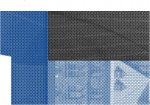I am having a debate with a co-worker. I was under the impression that when you have a 2 colour job, say Black and Reflex Blue, and there are greyscale images touching a screened blue background that the screen angles need to be different. She says no because they are only trapping, not a duotone. I have searched extensively online and can find nothing to support either arguement. I have attached a screen cap. Help!
Thanks,
Kim
Thanks,
Kim















